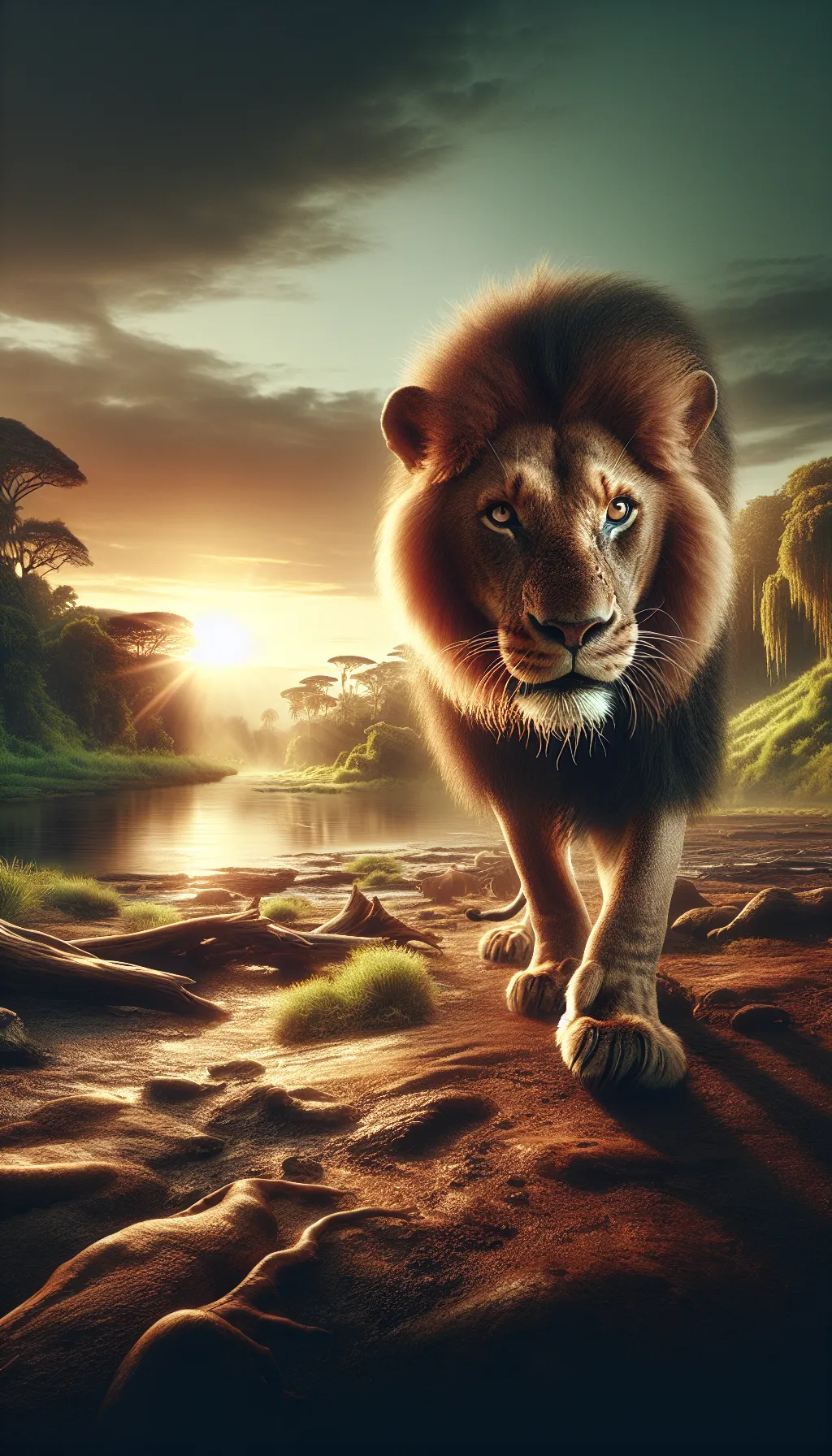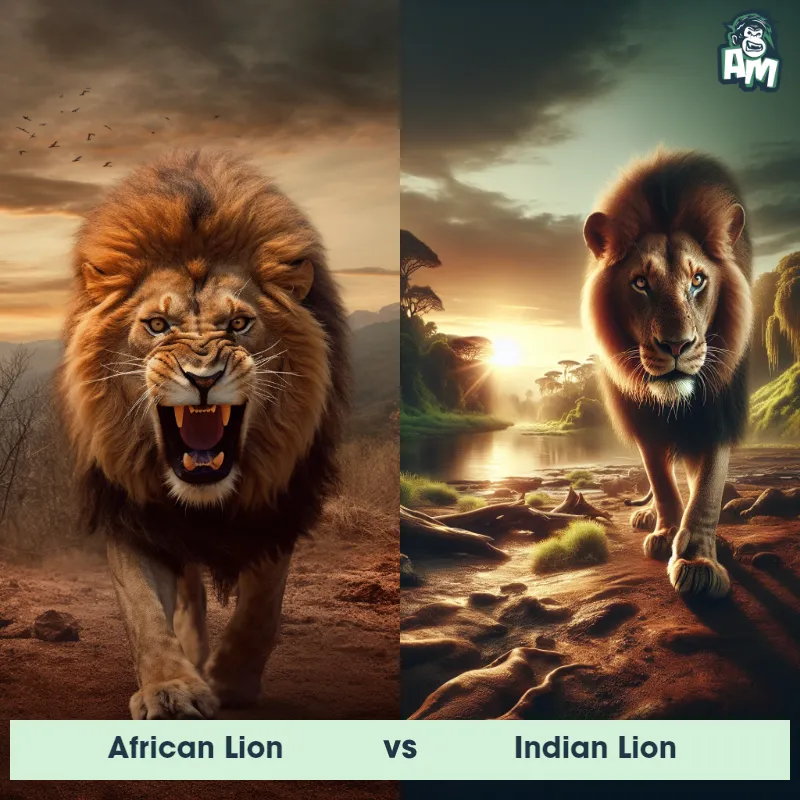The Indian Lion
The Indian Lion, also known as the Asiatic Lion, is a majestic big cat that is native to the Gir Forest in Gujarat, India. They have a muscular build and can weigh up to 500 pounds, making them one of the largest lion species. The Indian Lion has a sandy-brown colored fur with a short mane that covers their neck and extends down to their chest. Unlike African lions, most Indian Lions do not have large, fully-grown manes. They are known for their loud roars that can be heard up to 5 miles away, and they have a keen sense of hearing, sight, and smell.

| Indian Lion | |
|---|---|
| Size | Up to 9 feet (2.7 meters) |
| Weight | 420 pounds (190 kilograms) |
| Speed | 50mph (80km/h) |
| Key Strength | Strong limbs |
| Biggest Weakness | None specified |
| Scientific Name | Panthera leo persica |
| Family | Felidae |
| Habitat | Gir Forest of Gujarat, India |
| Geography | India |
| Diet | Deer, antelope, wild boar |
| Lifespan | 14 years - 16 years |

The Indian Lion
The Indian Lion, also known as the Asiatic Lion, is a majestic big cat that is native to the Gir Forest in Gujarat, India. They have a muscular build and can weigh up to 500 pounds, making them one of the largest lion species. The Indian Lion has a sandy-brown colored fur with a short mane that covers their neck and extends down to their chest. Unlike African lions, most Indian Lions do not have large, fully-grown manes. They are known for their loud roars that can be heard up to 5 miles away, and they have a keen sense of hearing, sight, and smell.
Fun Fact: Unlike their African counterparts, Indian Lions are not commonly known for hunting large prey such as elephants or giraffes, instead, they primarily feed on chital deer, sambar deer, and wild boar.
| Indian Lion | |
|---|---|
| Size | Up to 9 feet (2.7 meters) |
| Weight | 420 pounds (190 kilograms) |
| Speed | 50mph (80km/h) |
| Key Strength | Strong limbs |
| Biggest Weakness | None specified |
| Scientific Name | Panthera leo persica |
| Family | Felidae |
| Habitat | Gir Forest of Gujarat, India |
| Geography | India |
| Diet | Deer, antelope, wild boar |
| Lifespan | 14 years - 16 years |
Indian Lion Matchups
We use AI to simulate matchups between the Indian Lion and other animals. Our simulation considers size, strength, and natural predatory behaviors to determine the most likely outcome.

Can't find the Matchup you want?
Create Your Own MatchupIndian Lion: Diet, Predators, Aggression, and Defensive Behaviors
What do Indian Lions eat?
Indian Lions primarily feed on medium to large-sized prey animals such as deer, antelope, wild boar, and buffalo. They are powerful carnivores and typically hunt in groups to take down these herbivores for sustenance.
Do Indian Lions have any predators?
In their natural habitat, adult Indian Lions do not have many natural predators due to their size and strength. However, younger lions may fall prey to other predators like hyenas, leopards, and wild dogs.
Are Indian Lions aggressive?
Indian Lions can exhibit aggression, especially when defending their territory or offspring. They are known to be territorial animals and will defend their pride against other lions or potential threats.
Do Indian Lions fight?
Indian Lions are known for their intense battles amongst themselves, especially males competing for dominance within a pride. These fights can be brutal and often result in injuries or even death. They use their powerful jaws and sharp claws during these fights.
How do Indian Lions defend themselves?
Indian Lions have a few defense mechanisms to protect themselves from threats. They use their strong roar to warn off potential intruders, and they also have sharp claws and teeth that they can use in a confrontation. Additionally, they may band together as a pride to defend against larger threats.
What is the biggest weakness of Indian Lions in a fight?
Despite their strength and formidable reputation, Indian Lions have a vulnerability in prolonged fights due to their reliance on strength and stamina. If a fight extends for too long, they may become fatigued, making them more susceptible to attacks from their opponents.
Fun Fact: Indian Lions have a unique social structure where they live in small family groups called prides, consisting of 2 to 3 adult males, several females, and their cubs. The females are responsible for hunting while males protect the pride's territory.
Fun Fact: The Indian Lion is not only a symbol of power and courage but also holds cultural significance in Indian mythology and folklore. It is often associated with deities and has been depicted in ancient scriptures, sculptures, and paintings throughout history.











